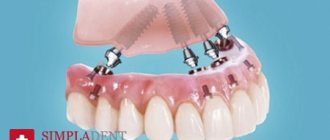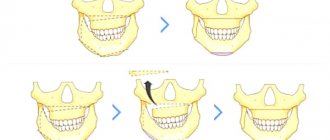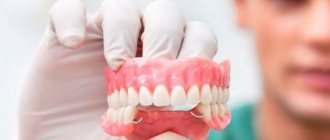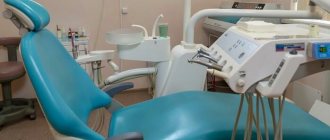The presence of milk teeth in adults cannot be attributed to the realm of fantasy or humor. This phenomenon can sometimes be encountered in dental practice. What contributes to the fact that a baby tooth can be preserved in adults and what to do with such a childhood “relic”?
Echo of childhood
Most people believe that baby teeth are closely associated with a touching and carefree childhood. It’s not for nothing that James Barry, a Scottish writer, in his fairy tale about Peter Pan - a boy who wants to always be young and not grow up - specifically describes that there were many milk pearl teeth in his mouth, and none of them had fallen out yet. Replacing baby teeth with permanent ones can be considered the same step into adulthood as the first room at school and the first two.
Teeth begin to change at about 5-6 years of age, and this process ends at about 12-14 years. Currently, according to the observations of many doctors, the replacement of baby teeth with permanent ones occurs in younger children than happened in past decades. But it also happens that baby teeth can be preserved in adults. Such cases can be encountered at 20, 30, and sometimes at 50 years of age. Why does this happen and what to do in such a situation?
Why are teeth bad?
Everyone has friends who are concerned about the health of their teeth, but at the same time do not get out of the dentist's chair, while others forget to brush them and are not familiar with the drill.
Alas, healthy teeth are largely the result of genetics, which can sometimes make up for even insufficient care and poor nutrition. Although “a mouth full of teeth” is still more common among those who brush them twice a day, undergo professional cleaning every year, do not overindulge in sweets, and heal caries in a timely manner. After all, in a person who has bad teeth from birth, even a small hole in a couple of months can turn into a huge cavity that destroys the tooth beyond the possibility of restoration.
Click to enlarge
How do dental tissues develop in humans?
Anatomically, a human tooth consists of a crown, neck and root. The visible part of the tooth is surrounded by hard tissues - enamel, dentin and cement, which protect the soft tissue - pulp. It extends from the crown of the tooth to its roots, has a large number of vessels and nerve endings and is directly involved in the nutrition of the entire tooth. Unfortunately, all tooth tissues undergo age-related changes, so in this case we are dealing with complex aging.
Dental development begins in the prenatal period. Already in the second month, the fetus develops an oral cavity with a dental plate. The rudiments of baby teeth form on it. By the fourth month, clear cell differentiation occurs. We can find anameloblasts, which are responsible for the formation of enamel, and dentinoblasts, which form the basis for dentin. By the sixth month, the outer and inner layers of dentin with a network of tubules are formed, and the gradual formation of pulp occurs, in particular the formation of collagen fibers.
How an implant becomes yours
Although the implantation technique was developed back in the 1970-1980s, many put up with the absence of teeth, believing that implants are painful, expensive and unreliable. According to statistics, 96% of operated patients use the same implants for more than 25 years. They can be installed in 20–30 minutes and are no more painful than removal. Artificial teeth are not cheap, but long-term treatment of hopeless teeth is even more expensive. The problem is that between tooth extraction and installation of a crown on an implant, an average of 2–3 months passes. But for this period, temporary crowns can be made. The main advantage of implants is that they completely restore chewing function, preserve adjacent teeth, and do not develop caries.
Back to the past. Outdated methods of dental treatment that it’s time to forget about Read more
If the tooth has not grown, we will pull it out
IF THE TOOTH HAS NOT GROWN, WE WILL PULL IT OUT
An orthodontist is a doctor who is especially popular today not only among children, but also among adults. It is relatively easy for children to straighten their teeth while the jaw bones are still young and pliable. But in adults, bite treatment is no longer a problem. Most often, orthodontic treatment is required when a person decides to undergo prosthetics. He comes, as expected, to the orthopedist, and he is immediately referred to the orthodontist. There are several reasons for this,” says medical orthodontist Roman Labzin.
One of the reasons is that there is not enough space in the mouth for dentures, which means that the dentition needs to be moved apart. Crowded teeth also require correction of their position. In general, an orthodontist is the first doctor who prepares the mouth for prosthetics.
Or could it happen that after visiting the orthodontist, you won’t need prosthetics? Will all teeth fall into place or will they successfully take someone else’s teeth?
Through orthodontic treatment, it is actually possible to replace missing teeth and do without prosthetics. For example, a patient once had his lower sixth teeth removed. He is faced with a choice - either to install an implant at great expense and cover it with a crown, or... to move nearby teeth. Typically, such people have problems with their bite and teeth alignment. By correcting the bite, I can close the gap of the extracted tooth - that is, kill two birds with one stone.
Some kind of “epidemic” has begun with malocclusions - you walk around the city and see almost every second person has braces on their teeth, and, surprisingly, in adults.
And this is not surprising. It is adults who most often turn to the orthodontist due to malocclusion. This problem actually occurs in every second person. The bad habits that adults instill in children, starting from infancy, play a detrimental role in this. For example, the habit of using a pacifier. I had a girl who did not take the pacifier out of her mouth until she was six years old. And as they get older, children begin to eat incorrectly—swallowing food, chewing it poorly. Apparently, looking at adults who are always in a hurry somewhere. Due to products that are already sold in a “chewed” state - yoghurts, muesli, baby purees, children and teenagers no longer need to chew, therefore teeth do not grow, jaws do not change and an anomaly is formed. Add here pathologies from the nasal cavity - adenoids, which in our humid climate develop in almost all children, and you get another reason for improper development of the jaw.
How exactly do adenoids affect teeth?
Due to adenoids, nasal breathing is impaired, and the child constantly breathes through the mouth. His lower jaw droops, and his upper jaw becomes very narrow, so there is not enough space for all his teeth, and they grow, overlapping each other. There are many reasons for the development of malocclusion. The most important function of teeth is chewing, so chewing is essential for both children and adults.
And if an adult has nothing to chew, is it not harmful for him to go without teeth for years?
Of course, it is harmful, now for the gastrointestinal tract, since undigested food causes gastritis and ulcers. In addition, ten years after losing teeth, such deformations will occur in the oral cavity that it will be very difficult to restore a normal bite. Rational prosthetics must be done on time.
How long after root removal do I have to wait before getting prosthetics?
It is better to do this within six months, or at most, up to a year.
How does your bite change with age?
First of all, the depth of the bite changes. While eating, the teeth rub against each other and gradually wear down and decrease in height. Such physiological wear of teeth over the years can significantly shorten them and lead to periodontitis. When this process occurs too quickly, pathological tooth wear develops, which causes a deep bite. A deep bite is a jaw condition in which the upper teeth overlap the lower teeth by more than one-third of the incisor crowns.
So, you should nibble on carrots while you’re young, and switch to more gentle food as you get older?
Of course, after 50 years it is better to take care of your teeth. Moreover, if the teeth wear evenly, the orthodontist will not help. Then it is better to contact an orthopedist, who can prevent further tooth wear by placing crowns on them.
What other bite pathologies are there?
Medial bite – when the lower jaw protrudes and the lower teeth protrude above the upper teeth. This pathology does not give a very aesthetic appearance to the face, but it is most often congenital and genetically inherited. Orthodontic treatment will not help here; maxillofacial surgery is necessary.
Changing the bite does not have a very good effect on appearance...
Yes, a decrease in bite height due to tooth wear leads to a visual reduction in the lower third of the face and a deepening of the nasolabial fold. Of course, this ages the face. Therefore, dental prosthetics and, accordingly, orthodontic treatment should be carried out in due time.
Until what age can a bite be cured?
One client I gave braces to was 58 years old. She had an impacted canine - a tooth that had formed at one time, but never erupted. Many years ago, the dentist apparently did not notice it, and when her baby tooth fell out, he gave her a denture, which she wore all her life. And we carried out orthodontic treatment and pulled this canine out. Now she has her own real tooth.
How often do such situations occur?
I have several patients with impacted fangs, some have one tooth left in the bone, others have both. Quite often the upper incisors fail to grow in, this happens for various reasons. One of the most common is the removal of baby teeth in early childhood. It very rarely happens the other way around. Milk teeth are retained until a person is 25 years of age or older. And the permanent tooth not only does not grow, but is completely absent from the bone. Then you have to place an implant and also carry out orthodontic treatment. Braces are the most popular type of correction among people. And when they do not help, then you have to resort to other structures, including removable ones. There are many treatment methods, of which I choose only those that are suitable for a particular person with his bite and problems.
What are the main indications for treatment by an orthodontist?
The main indication is teeth that are incorrectly positioned or grown in the wrong place. Of course, a greatly altered bite, which we have already talked about. Small changes in the bite are difficult for a person to determine on their own, so it would not hurt for every person to come for a consultation with an orthopedist at least once.
You can go to the orthodontics section at the multidisciplinary clinic “Panorama Med” here .
To make an appointment with an orthodontist, call: +7 (812) 244-90-10 and 8 (812) 970-00-70
One day dentistry
Just a few years ago (and in some clinics even now), installing crowns took at least a month and required 4–6 visits to the dentist. Modern computer technologies make it possible to do this in 1–3 visits to the doctor. Dental impressions are becoming a thing of the past. Now, using an optical digital scanner, in 5-10 minutes the doctor receives a digitized image of the dentition, which is sent to a machine - a Triumfus multi-axis processing center (the latest development of the military-industrial complex together with dentists), on which the crown is machined automatically in 14-16 minutes. The machine can produce 200 crowns per load. The development marked the beginning of a new industry - dental machine tools. Work on it can be carried out at night and on weekends without human intervention. Thanks to this, one-day dentistry arose.
Until what age do human teeth grow?
Baby teeth begin to erupt before one year of age. As a rule, at 2-2.5 years a child receives a full set of baby teeth. The molars are located immediately behind the milk teeth: between them there is a partition that is destroyed during the eruption of permanent teeth. The change of teeth in a person begins at the age of 6-7 years: the upper incisors usually fall out first. The milk bite is replaced by a permanent one at about 12-13 years of age. Molars develop more slowly than baby teeth, and the roots of wisdom teeth can continue to form up to 23 years of age and even later.
How are teeth related to the health of the whole body?
It is known that horses are chosen based on their teeth. Do people have strong teeth as an indicator of excellent health?
In Asia, there is a belief that teeth are a person’s karmic knots, and the loss of a tooth is associated with damage to karma. They believe that by healing a tooth, you can restore karma.
According to the Chinese method, each tooth is associated with a specific organ. This is partly confirmed by modern research. It has been established that there are 80 diseases that are based on a source of infection located in the teeth or gums. Once inside the body with the bloodstream, the infection can lead to the development of heart and vascular diseases, and bacteria living in dental plaque can cause pneumonia.
Traditional methods of “treating” teeth. The dentist analyzed 5 popular methods Read more
Treatment
At an early age, treatment is aimed at actively stimulating proper growth and formation of teeth, as well as diagnosing and preventing their deformation.
Once the main 7 permanent teeth have erupted, you can begin to think about replacing missing ones. In most cases, such treatment is preceded by special preparation carried out by the orthodontist, and then subsequent procedures to restore the missing tooth.
Treatment methods:
- Dental prosthetics using metal-plastic or zirconium oxide-based crowns;
- Adhesive bridge;
- Dental implantation;
For example, with symmetrical defects (no fangs), the doctor may suggest moving the nearest teeth in place of the missing ones to replace them. It is possible to transform nearby teeth (premolars) into fangs by applying a special photopolymer-based material to them. But, in the field of dental treatment, this is aerobatics, which is not accessible to everyone. And now we are not talking about the financial situation, you also need to find an experienced doctor, namely a restorative orthodontist.
Removable prosthetics and implants will help in the fight against edentia
In case of complete secondary adentia (when teeth are completely missing), treatment methods can only be removable prosthetics or, in some cases, installation of implants. Partial secondary adentia can be treated by so-called “ orthodontic preparation ”, in simple terms - prosthetics.
Who are the enemies of implants?
Smoking reduces the lifespan of artificial teeth most significantly. Natural teeth are protected from tobacco aggression by the circular ligament and the mucous membrane attached to it, which acts as a barrier. Implants do not have such protection.
They also do not have periodontal tissue (the connective tissue surrounding the tooth), due to which their natural teeth feel pain when biting into hard food. You can bite through barbed wire with the implant without feeling any discomfort. Therefore, a person who has several implants in his mouth can periodically chew through bones, ribs, small pebbles that have fallen into food, etc. If this is done regularly, even the titanium from which they are made can collapse over time.
Description and symptoms of the problem
The germ of a retention tooth is located in the bone, but its further growth does not occur for a number of specific reasons. This phenomenon is considered anomalous if the element has not erupted within two years from the due date.
In the partial form of the pathology, part of the crown is located above the gum or its outline is visible through the gum tissue. With complete retention, both the crown and root remain completely hidden. Typically, this problem affects the incisors, canines and the outermost “eights”. To clarify the position and shape, an x-ray examination is often required.
Typically, patients note an increase in body temperature and general malaise during teething, swelling and a change in the shade of the mucous membrane. In addition, if the element is fully formed in the bone tissue, but does not appear on the surface, pronounced pain may occur (most often it is monotonous). This indicates that the tooth is pressing on the roots of its neighbors. In some situations, facial numbness is also noted, which is caused by pressure on the nerve endings. It is also worth noting that in some cases the pathology does not provoke the appearance of any obvious symptoms.
Why do fillings fall out?
The filling, no matter what material it is made of, is not without drawbacks. Essentially, it is glue, which in different layers has a different structure and degree of condensation. Therefore, any temperature difference in the mouth causes a change in its volume. Because of this, microcracks occur, which eventually destroy the filling.
Today, when a tooth is destroyed, dentists prefer to use inlays (prostheses shaped like the missing part of the tooth). They are made on multi-axis specialized machines (on the same Triumfus) from a solid block of zirconium dioxide or lithium disilicate, which is 2 times stronger than tooth enamel (the strongest material in the body). This design can be installed even on a completely destroyed tooth, of which only one root remains (provided that there are no cracks, remnants of old pins or inflammation in it). Using modern digital methods, this can be done in the presence of the patient in 30–40 minutes.
Or maybe a filling would be better? Debunking myths about crowns Read more
How can you avoid age-related changes with the help of modern dentistry?
Even though our teeth age along with the rest of our bodies over the years, this does not mean that it is impossible to maintain an attractive and healthy smile in old age. Rule number one is good daily hygiene. Rule number two is regular preventive visits to the dentist. Professional cleaning will help remove hard plaque and prevent the development of caries, and the remineralization procedure improves the condition of the enamel. Laser and physical therapy are now actively used to strengthen gums, therefore, if you have problems with periodontal disease, it is recommended not only to visit a specialized specialist, but also to monitor the health of your gums at home. Rule number three is a balanced and healthy diet, coupled with taking vitamin complexes. This will help not only the teeth and oral cavity, but also other systems of the body.
Publisher: Expert magazine about dentistry Startsmile.ru
Author of the material: Yaroslav Ikonnikov
By the way
Is it possible to grow new ones?
Japanese scientists, using stem cells, grew the rudiments of permanent teeth in rats. Domestic researchers have patented a technology for obtaining stem cells from the tissues of baby teeth. After a baby tooth is removed, stem cells can be isolated from it, frozen, and later used to grow a new tooth. While this technology is just being developed, it is possible that in the future doctors will be able to grow teeth to replace those that have fallen out right in the patient’s mouth.
Do adults need to have their baby teeth removed?
Undoubtedly, baby teeth can often cause problems in adults. Firstly, their service life is short, which is why their resistance to caries is much lower compared to permanent ones. Secondly, teeth that do not fall out on time can interfere with the growth of permanent teeth and also cause them to be incorrectly positioned. But this does not mean that if a baby tooth is found in an adult, it must be removed. Everything is individual and depends on the specific situation. Very often, it is recommended to leave baby teeth in adults that are well preserved so that they last as long as they can. After all, sometimes it happens that permanent teeth may never appear in their place.
In any case, what to do with a baby tooth in adults needs to be decided after an X-ray examination is carried out, which will help determine the presence or absence of the rudiments of an unerupted permanent tooth, as well as whether the process of resorption of the baby tooth root is ongoing. If the rudiments are not found and the roots of a baby tooth have not been reabsorbed, and it looks aesthetically pleasing and immobile, then such a baby tooth should not be removed. The same applies to cases where it is X-ray proven that the position of the permanent tooth is such that even after removing the milk tooth, it will not be able to erupt. However, in this case it is better to consult an orthodontist.









